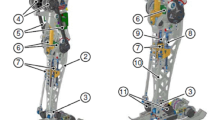Abstract
Biological snakes are capable of exploiting roughness in the terrain for locomotion. This feature allows them to adapt to different types of environments. Snake robots that can mimic this behaviour could be fitted with sensors and used for transporting tools to hazardous or confined areas that other robots and humans are unable to access. Snake robot locomotion in a cluttered environment where the snake robot utilises a sensory–perceptual system to perceive the surrounding operational environment for means of propulsion can be defined as perception-driven obstacle-aided locomotion (POAL). The initial testing of new control methods for POAL in a physical environment using a real snake robot imposes challenging requirements on both the robot and the test environment in terms of robustness and predictability. This paper introduces SnakeSIM, a virtual rapid-prototyping framework that allows researchers for the design and simulation of POAL more safely, rapidly and efficiently. SnakeSIM is based on the robot operating system (ROS) and it allows for simulating the snake robot model in a virtual environment cluttered with obstacles. The simulated robot can be equipped with different sensors. Tactile perception can be achieved using contact sensors to retrieve forces, torques, contact positions and contact normals. A depth camera can be attached to the snake robot head for visual perception purposes. Furthermore, SnakeSIM allows for exploiting the large variety of robotics sensors that are supported by ROS. The framework can be transparently integrated with a real robot. To demonstrate the potential of SnakeSIM, a possible control approach for POAL is considered as a case study.













Similar content being viewed by others
References
Sanfilippo F, Azpiazu J, Marafioti G, Transeth A A, Stavdahl Ø, Liljebäck P (2016) A review on perception-driven obstacle-aided locomotion for snake robots. In: Proceedings of the 14th international conference on control, automation, robotics and vision (ICARCV), Phuket, Thailand, pp 1–7
Sanfilippo F, Azpiazu J, Marafioti G, Transeth AA, Stavdahl Ø, Liljebäck P (2017) Perception-driven obstacle-aided locomotion for snake robots: the state of the art, challenges and possibilities. Appl Sci 7(4):336
Quigley M, Conley K, Gerkey B, Faust J, Foote T, Leibs J, Wheeler R, Ng AY (2009) ROS: an open-source robot operating system. In: Proceedings of the IEEE international conference on robotics and automation (ICRA), workshop on open source software, vol 3, no. 3.2, p 5
Koenig N, Howard A (2004) Design and use paradigms for gazebo, an open-source multi-robot simulator. In: Proceedings of the IEEE/RSJ international conference on intelligent robots and systems (IROS), vol 3, pp. 2149–2154
Won J, DeLaurentis K, Mavroidis C (2000) Rapid prototyping of robotic systems. In: Proceedings of the IEEE international conference on robotics and automation (ICRA), vol 4, pp 3077–3082
Liljebäck P, Pettersen KY, Stavdahl Ø, Gravdahl JT (2014) Compliant control of the body shape of snake robots. In: Proceedings of the IEEE international conference on robotics and automation (ICRA), pp 4548–4555
Liljebäck P, Pettersen KY, Stavdahl Ø, Gravdahl J T (2014) A 3d motion planning framework for snake robots. In: Proceedings of the IEEE/RSJ international conference on intelligent robots and systems (IROS), pp 1100–1107
Leon J, Paez L, Melo K (2013) Modular snake ros. In: Proceedings of the ROS developer conference (ROSCon2013)
Melo K, Leon J, di Zeo A, Rueda V, Roa D, Parraga M, Gonzalez D, Paez L (2013) The modular snake robot open project: Turning animal functions into engineering tools. In: Proceeding of the IEEE international symposium on safety, security, and rescue robotics (SSRR), pp 1–6
Krupke D, Hendrich N, Zhang J, Zhang H (2016) Gait optimization based on physics simulation of 3d robot models with a modular robotic simulation system. In: Proceedings of the 18th international conference on CLAWAR 2015, pp 612–619
Kam HR, Lee S-H, Park T, Kim C-H (2015) Rviz: a toolkit for real domaIn: data visualization. Telecommun Syst 60(2):337–345
Kendoul F (2013) Towards a Unified Framework for UAS autonomy and technology readiness assessment (ATRA). In: Nonami K, Kartidjo M, Yoon K-J, Budiyono A (eds) Autonomous control systems and vehicles, ser. intelligent systems, control and automation: science and engineering, no 65, Springer, Tokyo, pp 55–71. https://doi.org/10.1007/978-4-431-54276-6_4
Rumbaugh J, Jacobson I, Booch G (2004) Unified modeling language reference manual, the. Pearson Higher Education. https://www.utdallas.edu/~chung/Fujitsu/UML_2.0/Rumbaugh--UML_2.0_Reference_CD.pdf. ISBN 0-321-24562-8
Open Source Robotics Foundation (2016) Tutorial: Using a URDF In: Gazebo. http://gazebosim.org/tutorials/?tut=ros_urdf. Accessed Aug 2018
Open Source Robotics Foundation (2016) Tutorial: Using Gazebo plugins with ROS. http://gazebosim.org/tutorials?tut=ros_gzplugins
Holden C, Stavdahl Ø (2013) Optimal static propulsive force for obstacle-aided locomotion In: snake robots. In: Proceeding of the IEEE international conference on robotics and biomimetics (ROBIO), Shenzhen, China, pp. 1125–1130
Sanfilippo F, Stavdahl Ø, Marafioti G, Transeth A A, Liljebäck P (2016) Virtual functional segmentation of snake robots for perception-driven obstacle-aided locomotion. In: Proceedings of the IEEE conference on robotics and biomimetics (ROBIO), Qingdao, China, pp 1845–1851
Bayraktaroglu Z Y, Blazevic P (2005) Understanding snakelike locomotion through a novel push-point approach. J Dyn Syst Meas control 127(1):146–152. http://cat.inist.fr/?aModele=afficheN&cpsidt=16829403
Liljebäck P, Stavdahl Ø, Pettersen K, Gravdahl J (2014) Mamba—a waterproof snake robot with tactile sensing. In: Proceedings of the IEEE/RSJ international conference on intelligent robots and systems (IROS), Sept. 2014, pp 294–301
Acknowledgements
The authors gratefully acknowledge the contribution of the students Stian Grøttum Danielsen and Guillaume Adam in the implementation of this work. This work is supported by the Research Council of Norway through the Young research talents funding scheme, project title “SNAKE—Control Strategies for Snake Robot Locomotion in Challenging Outdoor Environments”, project number 240072.
Author information
Authors and Affiliations
Corresponding author
Additional information
This work was presented in part at the 2nd International Symposium on Swarm Behavior and Bio-Inspired Robotics, Kyoto, October 29-November 1, 2017.
About this article
Cite this article
Sanfilippo, F., Stavdahl, Ø. & Liljebäck, P. SnakeSIM: a ROS-based control and simulation framework for perception-driven obstacle-aided locomotion of snake robots. Artif Life Robotics 23, 449–458 (2018). https://doi.org/10.1007/s10015-018-0458-6
Received:
Accepted:
Published:
Issue Date:
DOI: https://doi.org/10.1007/s10015-018-0458-6




